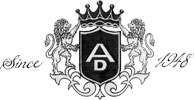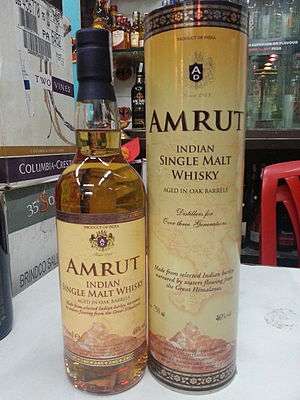Amrut Distilleries
Amrut Distilleries Ltd is an Indian company that produces distilled beverages. It is best known for its eponymous Amrut brand of single malt whisky, which is the first single malt whisky to be made in India.[2] The brand became famous after world famous whisky connoisseur Jim Murray gave it a rating of 82 out of 100 in 2005 and 2010. In 2010, Murray named Amrut Fusion single malt whisky as the third best in the world.[3][4][5] John Hansell, editor of American magazine Whisky Advocate, wrote that "India's Amrut distillery changed the way many think of Indian whisky - that it was, in the past, just cheap Scotch whisky blended with who knows what and sold as Indian whisky. Amrut is making whisky, and it's very good".[6]
 | |
| Privately held company | |
| Industry | Alcoholic beverages |
| Founded | Bangalore, Karnataka, India (1948) |
| Founder | J.N. Radhakrishna Rao Jagdale |
| Headquarters | Rajajinagar, Bangalore, Karnataka , India |
Area served | Worldwide |
Key people | |
| Website | www |
Despite the fame the company has received for the single malt whisky, it accounted for only 4-5% of the company's revenue in 2011-12. The bulk of its revenue comes from the sales of brandy, rum, vodka, gin and blended whisky, particularly the Silver Oak brandy, Old Port rum and Prestige whisky brands.[3][4][6] Approximately 20% of its revenue comes from supplying the Canteen Stores Department.[3] Amrut Distilleries currently sells Amrut single malt whisky in 23 countries, including Australia, Belgium, Canada, Denmark, Finland, France, Germany, Italy,[7] Japan, the Netherlands, Norway, Singapore, Spain, South Africa, Sweden, Switzerland, Taiwan, the United Kingdom and the United States.[3][4][8]
History
Founder JN Radhakrishna Rao Jagdale established a company called Amrut Laboratories in Bangalore, Karnataka in 1947, with an initial investment of a few hundred thousand rupees.[9] Amrut is a Sanskrit word which can be translated as "nectar of the gods",[4][10] "nectar of life",[11] or "drink of the gods".[12] The company translates it as "Elixir of Life".[13] Following the liberalization of alcohol licensing laws, distillery licenses were easier to obtain. Jagdale took the opportunity to enter the liquor market by founding Amrut Distilleries Ltd in 1948.[14] Today, Amrut Distilleries Ltd operates as a subsidiary of the N.R. Jagdale Group,[15] an Indian industrial group, based in the city of Bangalore.[1] The first plant was a liquor blending and bottling unit, specializing in Indian Made Foreign Liquor (IMFL).[1][16] The current main distillery was built in 1987.[17] It is located on a 4-acre (1.6 ha) site[6] in Kambipura on Mysore Road,[18] roughly 20 kilometres from Bangalore.[6][19][20]
Amrut Distilleries launched its first brand called Silver Cup brandy in Karnataka in 1949. The company began supplying liquor to the Canteen Stores Department in 1962 and continues to supply some of its domestic brands to the military.[4] Radhakrishna Jagdale's son, Neelakanta Rao Jagdale, joined the family business in 1972. The higher standard of living that was becoming more prevalent in the country led to a higher demand for good quality liquor.[14] Radhakrishna died in 1976, and his son assumed the role of chairman and managing director of the company.[9] The company faced difficulties until the 1990s, as good equipment was not available locally. According to Neelakanta Jagdale, "The alcoholic beverages industry was not a priority in the country. Although we received help to a certain extent from the Central Food Technological Research Institute (CFTRI), we had to find our own ways to learn about improved distilling methods".[14]
In 1982, Jagdale had decided to create a premium whisky from barley[6] blended with malt, while most distillers in India were manufacturing whisky using molasses. Amrut Distilleries began using locally grown barley, in addition to molasses,[19] and launched Prestige Blended Malt Whisky in the Canteen Stores Department in 1986.[4] The first batch of single malt whisky was ready within 18 months. Because India had no culture of consuming single malt at the time, the company did not consider bottling it as a single malt. Instead, the whisky was blended with alcohol distilled from sugarcane to produce MaQintosh Premium Whisky.[17] Initially, Amrut aged malt whisky for around a year before blending it. However, due to changing customer preferences, less malt whisky was being added into blended variants.[4] The company discovered that hot weather makes whisky mature faster in India than it does in Europe or the United States. The fraction lost to evaporation during ageing, known as the angels' share, is also higher in India, at 11–12% per year, than in Scotland, where the annual evaporative loss is about 2%.[4] Surinder Kumar, the master blender at Amrut Distilleries, has estimated that one year of barrel-ageing in India is equal to three years of ageing in Scotland.[6] Jagdale felt that "the taste profiles were much better, almost matching some of the 12-year-old [Scotch] whiskies".[4] The company then decided to launch their whisky in the European market.[4]

In 2001, Neelakanta Rao Jagdale asked his son Rakshit Jagdale, who was pursuing an MBA course in Newcastle, England at the time, to investigate the potential of exporting their products to that country.[6] Consultants Tatlock and Thomson Ltd of Scotland[19] were hired to help hone the company's processes at their Bangalore distillery.[6] Amrut Distilleries conducted blind tests of their single malt whisky in Scotland, where most consumers said they liked the drink and compared it to Speyside single malts.[4][21][5]
The whisky, under the brand name Amrut Single Malt Whisky, debuted in Europe on 24 August 2004.[22][21][4][23] The company faced difficulties convincing European distributors and consumers to the try the product, as most believed that a good single malt could not be produced in India. According to head of international operations Ashok Chokalingam, the initial strategy of offering the product in restaurants was dropped, as "the resources needed are too high, both financial and human". They switched their focus to retailers and bars.[6] Following the UK launch, the brand spread across Western Europe and the Scandinavian countries within two years.[2]
On 4 February 2010, Amrut Distilleries held a tasting session in Bangalore to launch their single malt whisky. The brand began retailing in Bangalore the same month.[19] Domestically, it continued to be available only in Karnataka[2] until November 2013 when it was launched in Mumbai.[24] The company went with a Scottish launch for marketing reasons. According to Neelakanta Jagdale, "From a marketing perspective, we thought if our product had to pass the test, why not do so in the toughest location. Scotland is the home of Scotch. If they acknowledge our single malt, then that's good enough for me".[14] The company also feels that "the high entry costs and complex excise laws in different states are a deterrent to further expansion in India".[4][17] The brand was launched in North America in April 2010. Purple Valley Imports is its distributor in the United States.[2]
Production
Amrut Distilleries began with a single blending and bottling unit, specializing in IMFL.[1][16] Amrut's current main distillery was built in 1987.[17] It is located in Kambipura on Mysore Road,[18] roughly 20 kilometres from Bangalore.[6][19][20] In addition to the original distillery, company also has a re-distillation plant to produce extra neutral alcohol for captive consumption and a bottling unit in Kerala.[9][25] The company decided against using computers and automation in their distillery in favour of providing more jobs to people.[17] The Bangalore distillery employs 450 people. Its distillery operation is highly labour-intensive and bottles are manually packed.[26] Most of the staff at Amrut Distilleries involved in bottling and packaging are women.[20] The distillery produces 4 million cases of liquor a year, of which about 25% are blended whisky and around 10,000 cases are single malt.[17] The malt for the whisky is grown in regions Punjab and Rajasthan. The barley is transported for about 2500 km (1600 miles).[27]
Amrut Distilleries is headquartered in the Rajajinagar neighbourhood of Bangalore.[28]
Products
Amrut Distilleries manufactures whisky (blended and single malt), brandy, rum, vodka and gin.[29]
|
|
|
See also
- Indian whisky
- Indian Made Foreign Liquor (IMFL)
References
- "Management Team". Amrutwhisky.co.uk. Retrieved 21 June 2013.
- Ishani Duttagupta (29 April 2012). "How India's first single malt brand Amrut Distilleries cracked luxury market in West". The Economic Times. Retrieved 21 June 2013.
- "Now, Amrut Distilleries mulls premium rum". The Financial Express. 6 October 2010. Retrieved 21 June 2013.
- "High Spirits". Outlook. 18 February 2012. Archived from the original on 8 March 2012. Retrieved 21 June 2013.
- "Raising a toast". The Telegraph. Kolkotadate=2010-03-14. Retrieved 21 June 2013.CS1 maint: location (link)
- "The malt of India". Business Standard. 18 February 2012. Retrieved 21 June 2013.
- "The whiskey diaries". GlobalPost. 26 May 2009. Retrieved 21 June 2013.
- "Awards Pour in For Amrut Distilleries". WhiskyIntelligence.com. 30 March 2012. Retrieved 21 June 2013.
- "About Amrut Distilleries". Amrutdistilleries.com. Archived from the original on 8 July 2013. Retrieved 21 June 2013.
- "Fusion whisky: When Glasgow met Gangtok". Life.nationalpost.com. 16 March 2011. Archived from the original on 24 June 2013. Retrieved 18 July 2013.
- "Outlook Business". Amrut Distilleries. Archived from the original on 14 July 2013. Retrieved 18 July 2013.
- "Whisky - Scotsman.com". Whisky.scotsman.com. 13 April 2004. Retrieved 18 July 2013.
- "Amrut Single Malt". Amrutwhisky.co.uk. Retrieved 18 July 2013.
- "Bangalore's Amrut Distilleries hHigh on success". Daily News and Analysis. Retrieved 21 June 2013.
- "Amrut Distilleries Ltd: Private Company Information". Bloomberg BusinessWeek. Retrieved 21 June 2013.
- "Chairman's Statement". Amrutwhisky.co.uk. Retrieved 21 June 2013.
- Mahalingan, Kripa (18 February 2012). "High Spirits; Amrut Fusion is the only Indian brand to find global acceptance in the rarefied world of single malt whiskies". Outlook Business. Amrut Distilleries. Archived from the original on 14 July 2013. Retrieved 21 June 2013.
- "Kambipura to Edinburgh". The Hindu. 3 March 2005. Retrieved 21 June 2013.
- Poornima Mohandas (5 March 2010). "Blend it like Amrut". Livemint. Retrieved 21 June 2013.
- "The malt of India" (PDF). Business Standard. Archived from the original (PDF) on 22 July 2013. Retrieved 21 June 2013.
- "India's 'chocolate-ty' single malt finds favour with Scottish palates". Island.lk. 26 August 2004. Retrieved 21 June 2013.
- "Amrut launches its whisky in Scotland". The Economic Times. 26 August 2004. Retrieved 21 June 2013.
- William Lyons (25 August 2004). "Currying favour with Indian whisky". The Scotsman. Retrieved 23 June 2013.
- "Amrut Fusion: Bengaluru whisky one of the world's best single malts". 1 May 2014 – via The Economic Times.
- "About Amrut Distilleries". Amrutwhisky.co.uk. Retrieved 21 June 2013.
- "Destination Bangalore: Amrut Distillery - World Whisky Review". Connosr.com. 15 March 2012. Retrieved 21 June 2013.
- "Amrut". www.whisky.com.
- "Contact Us". Amrutwhisky.co.uk. Retrieved 21 June 2013.
- "Products", Amrut Distilleries (website). Retrieved 22 June 2013.